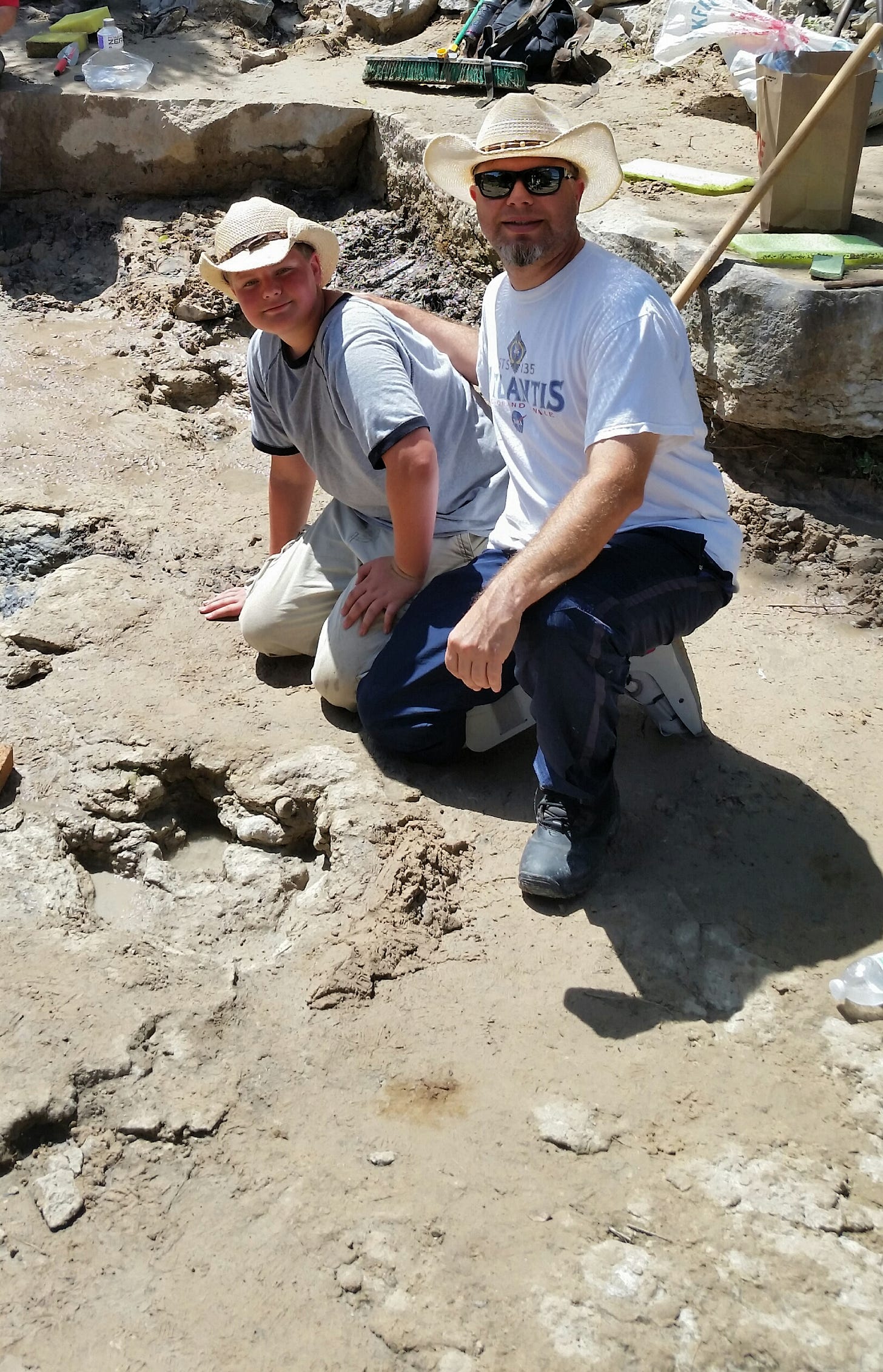Compared to dinosaur skeletons, fossilized dinosaur footprints might seem unremarkable. Yet, dinosaur footprints are more than mere impressions in stone—they are fossilized behavior, snapshots of ancient lives frozen in time. This is a branch of science called “Ichnology”. And sometimes, they record dramatic moments of prehistoric struggle.
In 1938, paleontologist Roland T. Bird of the American Museum of Natural History traveled to Glen Rose, Texas, to investigate reports of massive dinosaur tracks along the Paluxy River. What he found was extraordinary. Among the countless footprints embedded in limestone rock, one trackway stood out: the immense prints of a sauropod dinosaur, seemingly pursued. Running parallel and eventually converging with the herbivore’s path were the large, three-toed footprints of a predatory dinosaur, likely Acrocanthosaurus or a similar theropod. At the point where the two sets of tracks overlapped, something remarkable occurred—the predator appeared to skip a step, as if momentarily lifted off the ground. Bird interpreted this as a sign that the carnivore had lunged at the sauropod, sinking its teeth into its quarry and momentarily losing contact with the ground. In 1940, Bird excavated the trackway, sending it to the American Museum of Natural History in New York.
Archival video footage of Roland Bird and his field crew working on the dinosaur tracks in the Paluxy River near Glen Rose, Texas.
Learn more about the Lone Ranger Trail and the history of the Glen Rose Dinosaurs here,
Aaron Judkins & Tannon Judkins- Paluxy River upper ledge dinsoaur tracks
Dinosaur tracks are undeniably fascinating, but their very existence raises a significant question: how were these delicate impressions preserved before they were washed away by natural processes? The standard evolutionary explanation, which assumes slow and gradual geologic changes over millions of years, struggles to account for the rapid preservation required. Could the biblical Flood provide a more reasonable explanation?
Thousands of fossilized dinosaur footprints have been discovered worldwide, often forming long trackways of successive left and right footprints. These tracks provide insight into dinosaur movement, but they also create a puzzle for both secular and biblical geologists.
Acrocanthosaurus Dinosaur tracks infilled with green algae- Paluxy River, Glen Rose, TX.
photo by: Aaron Judkins
At first glance, dinosaur footprints appear to challenge the Flood model. Skeptics argue:
How could dinosaurs leave tracks during a Flood that covered the entire earth?
Even if they did, why wouldn’t the churning floodwaters quickly erase them?
These objections are often raised to dismiss the biblical account, sometimes with outright mockery. However, a closer look reveals that the real dilemma belongs to conventional geologists.
If geologic changes occurred slowly over millions of years, then footprints made in soft mud should have eroded long before they were covered and preserved in hardened rock. Rain, wind, and normal erosion would destroy them in days or weeks—let alone thousands or millions of years. If one thousands of an inch erodes in 1,000 years, then 60 million years of time equates to 60”or 5 feet of erosion on surface! All dinosaur tracks would be totally eroded away!1
So who truly has a problem explaining these tracks? To answer this question, let’s examine a specific case: fossilized dinosaur footprints in Israel.
Dinosaur Tracks in the Judea Group
Near the village of Beit Zeit, west of Jerusalem, an extraordinary sequence of fossilized dinosaur tracks has been discovered. These tracks include clearly preserved left foot–right foot impressions showing the three long toes characteristic of certain dinosaurs.2 But the most puzzling feature of these footprints is the type of rock in which they are found. These tracks are preserved in dolomite, a carbonate rock similar to limestone, but with a distinct chemical composition. My colleague, Joe Taylor traveled there and molded these tracks in what was to be his last project he did before he died.
Beit Zeit Dinosaur Tracks
Why Is This a Problem for Evolutionary Geology?
Dolomite is rarely found forming in today’s world, except in extreme environments such as:
Hot springs
Desert salt flats
Hyper-salty lakes and unusual oceanic conditions
These are not environments where dinosaurs could have lived, yet we find their footprints in dolomite deposits.3 This is inconsistent with the principle that the present is the key to the past, which assumes that geologic processes today are the same as those in ancient times.
A More Significant Problem: The Vast Extent of the Rock Layers
The dinosaur prints in Israel are not an isolated phenomenon. They are found in the lower section of the Judea Group, a massive sequence of alternating limestone and dolomite layers that are 2,600 feet (800 meters) thick.4
This rock group extends over a vast region, covering much of modern Israel, including Mount Zion and the Temple Mount (Mount Moriah). Given this scale, conventional geologists are forced to explain how such thick layers of marine-origin rock covered an entire region while dinosaurs walked across it.
If this area was once a shallow ocean—as the presence of dolomite suggests—how did land-dwelling dinosaurs make footprints on an ocean floor?
The Flood Model: A More Plausible Explanation
The biblical Flood provides a compelling answer to these questions. Unlike uniformitarian models that assume slow geologic change, the Flood was a catastrophic event, capable of rapidly depositing massive layers of sediment while creating temporary land surfaces.
How Did Dolomite Form in the Flood?
During the pre-Flood world, the ocean floor would have contained massive amounts of calcium carbonate, derived from the remains of marine organisms such as mollusks. When “the fountains of the great deep” broke open (Genesis 7:11), the following occurred:
Massive earthquakes lifted the ocean floor, forcing ocean water onto the land in tsunami-like waves.
Hot volcanic waters heated the ocean, increasing chemical reactions that altered the sediment composition.
Magnesium from volcanic activity mixed with the lime-rich water, leading to rapid dolomite formation.5
This catastrophic plate movement helps explain why marine-origin rocks like limestone and dolomite are so abundant on continents today.
Footnotes
Institute for Creation Research. "Erosion Rates and Dinosaur Tracks: Impact #317."
Freund, R. (1978). The Judean Hills and Galilee Regional Synthesis of Sedimentary Basins.
Blatt, H. (1992). Sedimentary Petrology (2nd ed.). W. H. Freeman and Company, pp. 295–307.
Bartov, Y., & Steinitz, G. (1977). The Judea and Mount Scopus Groups in the Negev and Sinai. Israel Journal of Earth Sciences, 26, 119–148.
Snelling, A. (2009). Earth’s Catastrophic Past: Geology, Creation and the Flood. Institute for Creation Research, pp. 723–726.
Thank you for reading Dr. Aaron Judkins Substack.
As a token of our appreciation, we're offering you a limited-time offer of 20% off a paid subscription for your first year.
Here are the benefits you unlock with a paid subscription:
Subscriber-only posts and full archive
Post comments and join the community
Thanks again for reading!
PS. If you loved this article, be sure to head over to our Ancient Pathways Patreon site and see my presentation on “Dinosaur Trackways”, the video “Dinosaur Pictograph: Kachina Bridge”, or the film “Forbidden History of Dinosaurs”. And be sure to check out our “Out of Place Artifacts” Digital Library!










